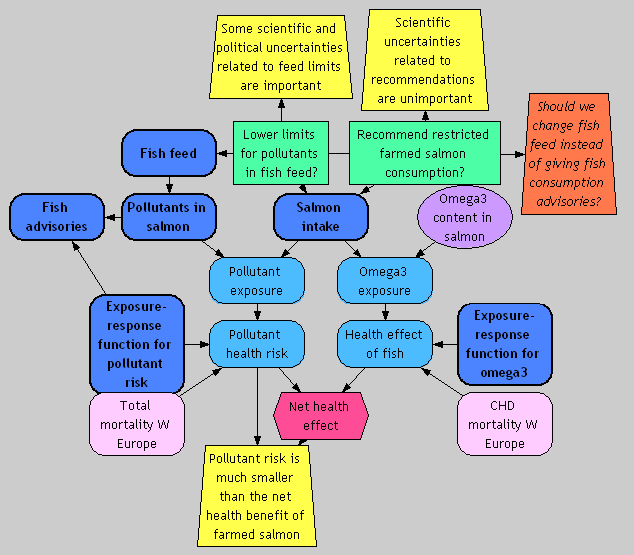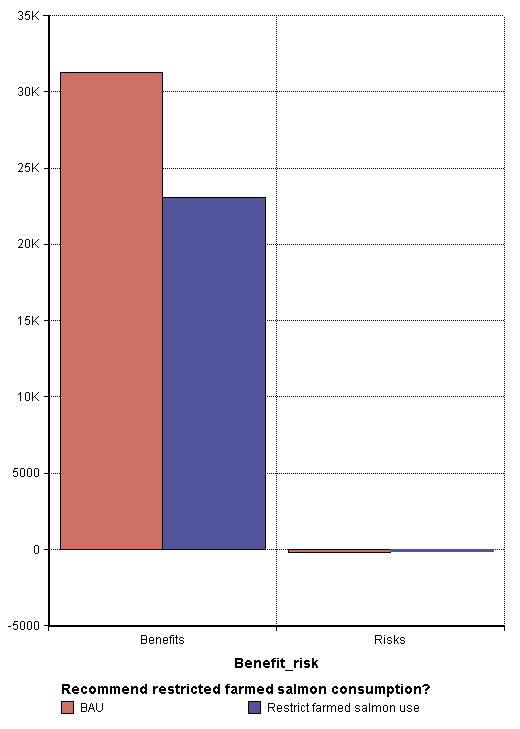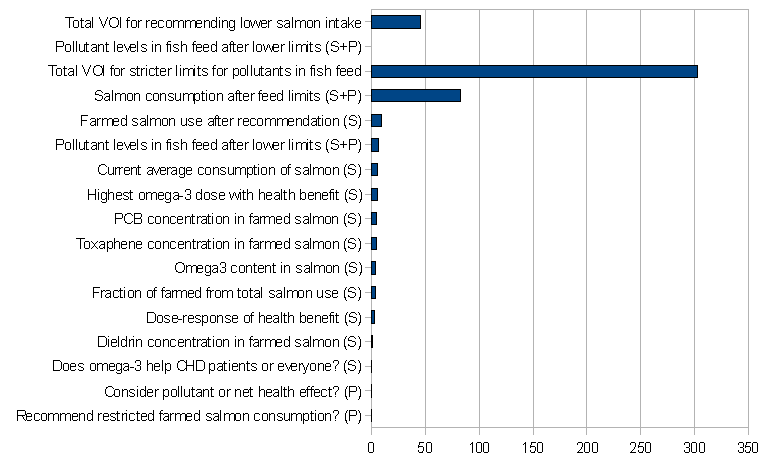Benefit-risk assessment on farmed salmon: Difference between revisions
Jump to navigation
Jump to search
(→Results: result table compared with BAU added) |
mNo edit summary |
||
| Line 3: | Line 3: | ||
===Purpose=== | ===Purpose=== | ||
'''The purpose''' of the assessment is to evaluate the recommendation given by Hites et al <ref>Hites et al. Science 2004. </ref> that people should not eat farmed salmon too often because of the pollutant concentrations. | '''The purpose''' of the assessment is to evaluate the recommendation given by Hites et al <ref>R. A. Hites et al. Global assessment of organic contaminants in farmed salmon. Science, 9 Jan. 2004, p. 226</ref> that people should not eat farmed salmon too often because of the pollutant concentrations. | ||
===Boundaries=== | ===Boundaries=== | ||
Revision as of 07:40, 31 December 2007
Scope
Purpose
The purpose of the assessment is to evaluate the recommendation given by Hites et al [1] that people should not eat farmed salmon too often because of the pollutant concentrations.
Boundaries
- Pollutants: Toxaphene, dieldrin, PCB
- Nutrients: Omega-3 fatty acids
- Health impacts:
- Total cancer caused by pollutants
- Cardiovascular deaths and the impact of omega-3 fatty acids
- Population: the population of Western Europe (European Economic Area as of beginning of 2004)
- Current situation (year 2004)
Scenarios
- Recommendation for not to eat farmed salmon too often (yes/no)
- Setting up new stricter regulations about pollutants in fish feed (yes/no)
Intended users
- The primary users are public health authorities and decision-makers involved in giving food recommendations.
- The secondary user group is the general public. Quantitative estimates are offered to increase understanding of the magnitudes of the related issues.
Participants
The assessment is restricted to a group of environmental health researchers. See participant list in Farmed salmon (project).
Definition
Analyses
- Value of information analyses
- Outcome: Net health effect; Decision: Recommend restricted farmed salmon consumption?; Variables tested: all
- Outcome: Net health effect; Decision: Lower limits for pollutants in fish feed?; Variables tested: all
- Importance analyses
- Outcome: Mortality by recommendation; Variables tested: all
- Outcome: Mortality by feed regulation; Variables tested: all
Result
Results
The main results and conclusions have been published by Tuomisto et al.[2]
Table: Net health impacts of eating farmed salmon. The results include the health impacts of the total health impact of omega-3 intake from salmon.
| Statistics or fractile | Business as usual | Recommend restrictions | Stricker rules for feed | Both |
| Mean | 31062 | 22929 | 31428 | 23296 |
| SD | 22650 | 17105 | 22842 | 17317 |
| 0.01 | 576 | 404 | 653 | 460 |
| 0.025 | 1782 | 1286 | 1847 | 1356 |
| 0.05 | 3632 | 2697 | 3766 | 2803 |
| 0.25 | 14547 | 10590 | 14780 | 10793 |
| 0.5 (Median) | 25187 | 18504 | 25479 | 18829 |
| 0.75 | 43064 | 31526 | 43628 | 32091 |
| 0.95 | 76141 | 56697 | 77010 | 57393 |
| 0.975 | 88267 | 66397 | 89040 | 67249 |
| 0.99 | 101832 | 79328 | 102202 | 80143 |
Table: Net health impacts of eating farmed salmon compared with the business-as-usual scenario.
| Statistics or fractile | Business as usual | Recommend restrictions | Stricter rules for feed | Both |
| Mean | 0 | -8133 | 366 | -7766 |
| SD | 0 | 9703 | 982 | 9637 |
| 0.01 | 0 | -45895 | -2335 | -45557 |
| 0.025 | 0 | -35624 | -1662 | -35171 |
| 0.05 | 0 | -27745 | -1155 | -27041 |
| 0.25 | 0 | -10929 | -60 | -10553 |
| 0.5 (Median) | 0 | -4876 | 264 | -4560 |
| 0.75 | 0 | -1567 | 820 | -1307 |
| 0.95 | 0 | -112 | 2117 | 147 |
| 0.975 | 0 | -10 | 2635 | 459 |
| 0.99 | 0 | 14 | 3180 | 995 |
Conclusions
- Pollutant risk is much smaller than the net health benefit of farmed salmon
- Scientific uncertainties related to recommendations are unimportant
- Some scientific and political uncertainties related to feed limits are important
References
- ↑ R. A. Hites et al. Global assessment of organic contaminants in farmed salmon. Science, 9 Jan. 2004, p. 226
- ↑ Tuomisto JT, Tuomisto J, Tainio M, Niittynen M, Verkasalo P, Vartiainen T, Kiviranta H, Pekkanen J. Risk-benefit analysis of eating farmed salmon. Science. 2004 Jul 23;305(5683):476-7 Read the article


